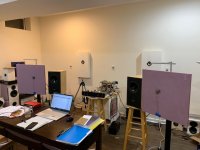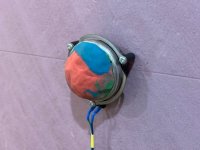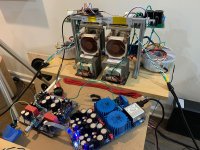JMatt,
That’s beautiful work! Is that CNC or some other process?
The ribs remind me sort of ribs on a wood panel. I wonder if adding ribs to the thin ply used for model airplanes and art craft jigsaw puzzles could work.
If someone has a large string instrument like a double bass, what would it sound like as a speaker with a DML exciter attached to it? I bet it would play cello or double bass solos very well! Need to attach at bridge point. That would be fun. 🙂
It might even play vocals well. You will get the characteristics tone wood resonance and decays of the actual instrument.
That’s beautiful work! Is that CNC or some other process?
The ribs remind me sort of ribs on a wood panel. I wonder if adding ribs to the thin ply used for model airplanes and art craft jigsaw puzzles could work.
If someone has a large string instrument like a double bass, what would it sound like as a speaker with a DML exciter attached to it? I bet it would play cello or double bass solos very well! Need to attach at bridge point. That would be fun. 🙂
It might even play vocals well. You will get the characteristics tone wood resonance and decays of the actual instrument.
Thanks xrk971, It's a very quick rough single pass CNC profile just to test out some different designs I made. So far out of the two the one with the ribs seems more efficient although the glue mix hasn't had much time to cure.
YouTubeJMatt,
That’s beautiful work! Is that CNC or some other process?
The ribs remind me sort of ribs on a wood panel. I wonder if adding ribs to the thin ply used for model airplanes and art craft jigsaw puzzles could work.
If someone has a large string instrument like a double bass, what would it sound like as a speaker with a DML exciter attached to it? I bet it would play cello or double bass solos very well! Need to attach at bridge point. That would be fun. 🙂
It might even play vocals well. You will get the characteristics tone wood resonance and decays of the actual instrument.
YouTube
Thanks for the links! I totally see a whole new use for thrift store/garage sale guitars now!
Acoustic DML full range speakers - on nice tone wood panels for cheap. They sound good for what they are actually. Perfect for guitar! I think leaving the strings would add some resonance effects.
Acoustic DML full range speakers - on nice tone wood panels for cheap. They sound good for what they are actually. Perfect for guitar! I think leaving the strings would add some resonance effects.
Welcome JMatt and well done. That is a very interesting approach and I look forward to hearing how it goes.
Burnt
Last edited:
OK I think I found my answer to the question of whether damping lowers or raises F0, the resonant frequency of a panel. It appears that it will lower it just a little. The heavier the damping the little lower F0 goes. I haven't yet found an equation that desribes this behavior but just the fact that F0 goes down a little is what I wanted to hear. However, the compromise in that is that your sensitivity will obviously drop with additional damping.
Theres also a point called Critical Damping wherein you can completely stop a resonant vibration without over damping things. It would be nice to know that equation as well or at least be able to tell how much damping will effect a resonance. That will at least give us an analytical way to apply damping properly rather than just trying to guess so much.
Hopefully this doesn't lead to too much analysis paralysis...
Theres also a point called Critical Damping wherein you can completely stop a resonant vibration without over damping things. It would be nice to know that equation as well or at least be able to tell how much damping will effect a resonance. That will at least give us an analytical way to apply damping properly rather than just trying to guess so much.
Hopefully this doesn't lead to too much analysis paralysis...
Jmatt,
Very cool (both panels). But can you explain what you hope to achieve? Solid XPS is already the most efficient panel I've heard. Are you trying to make it even more efficient? Do you have another specific goal(s)? Or are you just seeing what happens? (I'm asking just to better understand what you have in mind, not to "challenge" your idea in any way!).
If you want to really maximize stiffness/weight (maybe you do, maybe you don't), you could make (mirror images) of your ribbed panels and glue them together back to back.
Thanks,
Eric
OK I think I found my answer to the question of whether damping lowers or raises F0, the resonant frequency of a panel.
I do plan to answer you on this, just haven't had time yet!
Eric
NP, Eric! The article I found that hints that F0 gets slightly lowered by damping, while useful, was way too vague on specifics and didn't provide a reference or anything. And as usual the more I read, the more questions I end up having, which leads to more searching and reading ad naseum... LOL. But I'm just about at the point where I think I can build something according to theory that should work pretty well.
Can't stop thinking about the guitar soundboard. I may have to bookmatch a feathered Sitka spruce panel and coat with some violin varnish. Interesting thread.
Jmatt,
Very cool (both panels). But can you explain what you hope to achieve? Solid XPS is already the most efficient panel I've heard. Are you trying to make it even more efficient? Do you have another specific goal(s)? Or are you just seeing what happens? (I'm asking just to better understand what you have in mind, not to "challenge" your idea in any way!).
If you want to really maximize stiffness/weight (maybe you do, maybe you don't), you could make (mirror images) of your ribbed panels and glue them together back to back.
Thanks,
Eric
Thanks Veleric, I'm just experimenting a bit with what I have available. Originally I wanted to try a XPS honeycomb with wood veneer on both sides but it's just too difficult to source here.
Now your other statement about f0 depending on panel suspension. I assume you mean dampening of the panel (at least around the periphery.) i.e., going from an infinite plane structure to a finite one. Can you explain to me does such damping increase or decrease the F0 and are their equations that may describe the effect on F0 by dampening.
geosand,
Finally getting back to this question:
When I noted that f0 depends on panel suspension, what I meant by "suspension" has more to do with how the panel is held in place (or not), than how or if it is damped. That, for example, is the panel hanging from strings or clamped in a frame? While it is true that such frame might include a damping effect, with or without damping, the suspension mechanism has a pretty significant effect on f0 (and much more than damping alone does).
Engineers may refer to "suspension", "boundary" conditions" or "constraints" and generally be referring to how a structure is held. Some typical boundary conditions are :
1) Free,
2) Pinned, or hinged or "simply supported"
3) Clamped, built-in, or cantilevered
The first (free) means no support at all. Hanging from strings is about as close to "free" as you can get. The edges of the panel are not held in place so move (and rotate) freely without constraint.
The second (pinned) means the edges are fixed in place, but are still free to rotate, as if there was a hinge that ran around the entire perimeter of the panel. A panel whose edges are clamped around the perimeter between two narrow plates with a thin but soft foam would approach this condition.
The third, (clamped) means the edge is not only fixed in place, but held to prevent rotation at the point where it is held. A panel whose edges are clamped around the perimeter with a wide steel frame would approach this condition.
Regarding f0, the "free" conditions gives the lowest f0 of the three idealized boundary conditions that I described, "hinged" would have a higher f0, and "clamped" the highest of the three. I modeled (using finite element analysis) a particular panel with the three described boundary conditions and got f0 values of 37 Hz, 53 Hz, and 97 Hz for the free, hinged and clamped conditions, respectively.
Generally, the more restrictive the boundary conditions are, the more f0 is increased, as in the previous examples. I did find, however, that pinning just the four corners led to a lower f0 (19Hz).
All that said, I myself can't say what boundary conditions are best. It would seem that reducing f0 would be good for producing bass. But, interestingly, this patent claims that low frequency output is enhanced with clamped edges compared to free edges. Go figure...
https://patentimages.storage.googleapis.com/3c/12/36/2e7517cb3f2ffc/WO1999052324A1.pdf
Eric
Thanks Veleric, I'm just experimenting a bit with what I have available. Originally I wanted to try a XPS honeycomb with wood veneer on both sides but it's just too difficult to source here.
I presume you mean the XPS honeycomb is hard to source, (not wood veneer) right? Did you try wood veneer over plain XPS? I've been planning to try that or similar myself. I suspect the foam is so light already that it's weight is small compared to the wood veneer. So making the foam even lighter may be only of marginal benefit.
Thanks,
Eric
Ironically no, the XPS honeycomb I can cut on my CNC but finding a thin veneer that doesn't have MDF backing or in smaller quantities is the difficult part.
JMatt,
Not sure where you are at, but this is where I'll probably buy veneer if I decide to try using it. Not cheap, beasonable prices and small sizes, just about right the right size for DML panels.
PSA - Pressure Sensitive Veneer - 24 Inch X 32 Inch
I've actually been thinking about trying wood veneer over 3/16 foamcore poster board. The weight of the paper outer layers is a negative, but on the plus side they'd be a good surface to bond the veneer to. I gotta do some calculations to see if it makes sense or not.
Eric
Not sure where you are at, but this is where I'll probably buy veneer if I decide to try using it. Not cheap, beasonable prices and small sizes, just about right the right size for DML panels.
PSA - Pressure Sensitive Veneer - 24 Inch X 32 Inch
I've actually been thinking about trying wood veneer over 3/16 foamcore poster board. The weight of the paper outer layers is a negative, but on the plus side they'd be a good surface to bond the veneer to. I gotta do some calculations to see if it makes sense or not.
Eric
A wood veneer over a foamcore sounds very similar to gatorbaord/gatorfoam? What Ziggy found like 10 years ago that at first he really loved and really started this whole DML DIY efforts, but in the end abandonned it in favor corrugated cardboard w/shellac and then High Density EPS, which both also had HF issues. Till he passed he went back and forth between the CC and HD EPS and never stopped trying to find a better material. He also was never successful in coming up with a suspension/frame mechanism that he felt sounded better than just leaving his tall panels on the floor and resting it against his horn speaker to hold it up. i.e., a sort of free standing panel.
Gatorboard had no HF, I assume because its Critical Frequency was probably way too low. I haven't done the calcs but I would bet its Critical Freq was probably around 10Khz if not a tad lower.
Gatorboard had no HF, I assume because its Critical Frequency was probably way too low. I haven't done the calcs but I would bet its Critical Freq was probably around 10Khz if not a tad lower.
And thanks again Eric, I used to think that suspension was just another distinction of a type of damping without a real difference. But theoretically if a free panel gives lowest F0, you would still have to fight with potentially more damping to quell things...whether that's a good trade off or not, I guess that's where the experimenting comes in.
A few years ago my thought was to use a panel that was suspended in a frame via magnetic forces, i.e., the use of strategically placed small magnets along the bottom edge of the panel and 2 side edges to hold the panel vertically and side to side and then a few more magnets at like the front/back corners to keep it in place from front to back. That's about as free as we can achieve I believe and If I use some really small neo's might even be affordable as long as the panel wasn't too heavy...ahhh to have money to experiment... there's the rub...
Now that NXT patent I've read before as well (ok read is probably too strong as the language is so stilted toward patent legalese as to almost not be in english lol). None the less, It does seem to imply Clamping all around may be better, but they mention ignoring F0 and instead basing their theory around F1 which I don't understand at all and doesn't seem to jive with their LowEnd = 2.5*F0 equation...However, this may be a later paper and they have refined some of their theory and it may be based more toward heavy duty PA systems that need that extra built in toughness as opposed to home HI-FI.
The one thing I did notice was that they seem to mention several other key patents as being "enlightening" such as the early "Warnaka" patent which I believe may pre-date even Bertagni's stuff...I'll try to see if I can find some more of these foriegn patent docs NXT specifically mention that seemed to guide their own patents and theory...
Right now, I believe that NXT may have been playing a little loose with their theory and some of the later patents and research from others in academia seem to point that out and have some better clues/explanations...
So I think I have enough various different theory info and equations available now in terms of analysis of panels to determine which panel material might give me the best starting point for my design as well as best suspension...something which I have to do as I dont have the luxury of $$ or the wood/metal skills or equipment to endlessly experiment. Time I have, $$$ no :-( For me its start with whatever the theory says is a good place to go, then spend more time to experimentally play with various damping techniques to come up with a usable solution that will sound great. Thus all the tech questions...as always, you've been very helpful...and I'm sure I'll have a few more...
A few years ago my thought was to use a panel that was suspended in a frame via magnetic forces, i.e., the use of strategically placed small magnets along the bottom edge of the panel and 2 side edges to hold the panel vertically and side to side and then a few more magnets at like the front/back corners to keep it in place from front to back. That's about as free as we can achieve I believe and If I use some really small neo's might even be affordable as long as the panel wasn't too heavy...ahhh to have money to experiment... there's the rub...
Now that NXT patent I've read before as well (ok read is probably too strong as the language is so stilted toward patent legalese as to almost not be in english lol). None the less, It does seem to imply Clamping all around may be better, but they mention ignoring F0 and instead basing their theory around F1 which I don't understand at all and doesn't seem to jive with their LowEnd = 2.5*F0 equation...However, this may be a later paper and they have refined some of their theory and it may be based more toward heavy duty PA systems that need that extra built in toughness as opposed to home HI-FI.
The one thing I did notice was that they seem to mention several other key patents as being "enlightening" such as the early "Warnaka" patent which I believe may pre-date even Bertagni's stuff...I'll try to see if I can find some more of these foriegn patent docs NXT specifically mention that seemed to guide their own patents and theory...
Right now, I believe that NXT may have been playing a little loose with their theory and some of the later patents and research from others in academia seem to point that out and have some better clues/explanations...
So I think I have enough various different theory info and equations available now in terms of analysis of panels to determine which panel material might give me the best starting point for my design as well as best suspension...something which I have to do as I dont have the luxury of $$ or the wood/metal skills or equipment to endlessly experiment. Time I have, $$$ no :-( For me its start with whatever the theory says is a good place to go, then spend more time to experimentally play with various damping techniques to come up with a usable solution that will sound great. Thus all the tech questions...as always, you've been very helpful...and I'm sure I'll have a few more...
I flipped my panels around so that the exciters are front facing. I added some plastic modeling clay to the magnet to give it more mass in hopes of giving it more bass authority. The highs sound clearer now. Playing Bruce Springsteen 'Blood Brothers' - sounds fantastic. Then Ahmad Jamal's 'Ahmad's Blues' - very nice drums and pianos, and could hear ambience in night club very clearly (superb recording from 1955?), then next up was Lana DelRey's Summertime Sadness (Asadinho mix) - can actually hear some bass dance drums. What surprised me most is how well it played Metallica's 'Enter Sandman". Metal guitar and drums is usually hard to get right - not perfect, but very enjoyable. Patricia Barber's 'Manha de Carnaval' was refreshingly very lifelike - like you are there. Steely Dan's 'Hey Nineteen' sounded a bit too bright and forward. Buddy Guy's 'Five Long Years' was very good - nice visceral feel of his pain when he cries "You've got to know what I am talking about." These speakers really have some highs avaialble and great mid range. I measured about 3.5 vrms and that was about as loud as I could play it comfortably, about 85dB at listening position with my sound meter.
I almost forgot to mention, I am powering them with my very best reference amp and that seems to make a very nice difference. Source are FLAC or WAV files from Jriver on PC through Focusrite 2i4 DAC feeding a Yarra/Melbourne preamp, which drives a 50w SE Class A amp with microwave transformer 67mH 0.5DCR choke reactive load and SLB power supply with 37Vdc and 4.7A bias current (Hugh Dean's Glass Harmony). So, give it your best amp, you might be surprised how good it sounds!
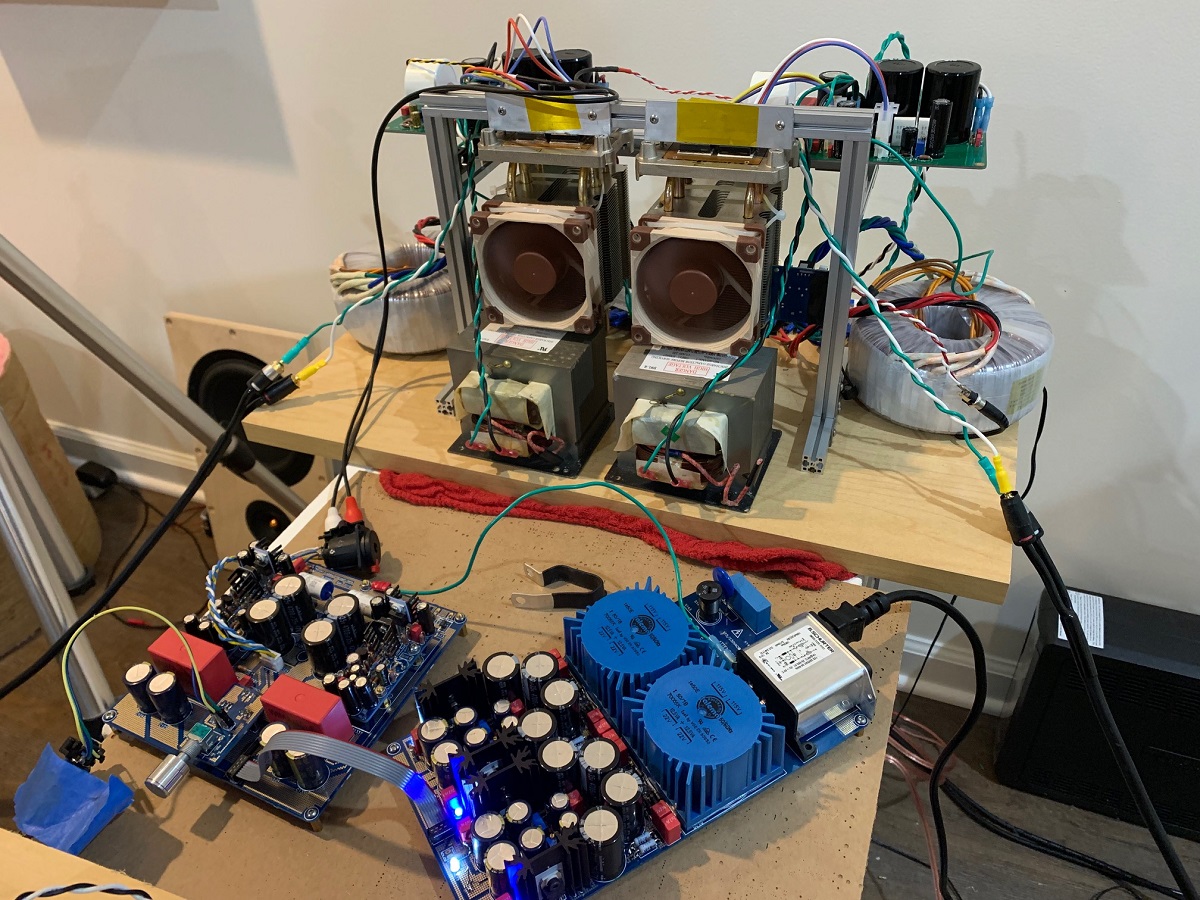
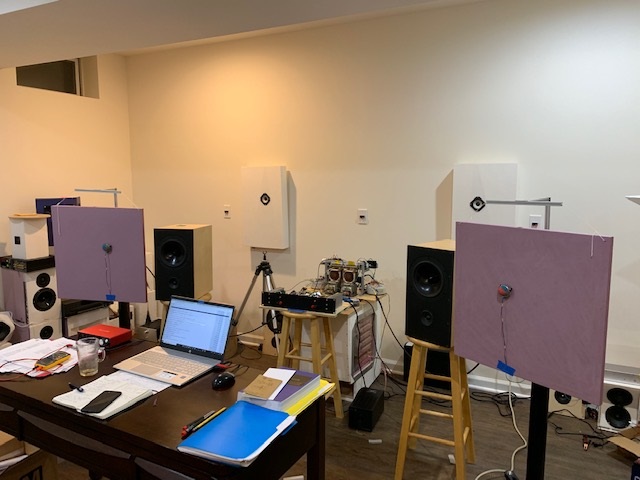
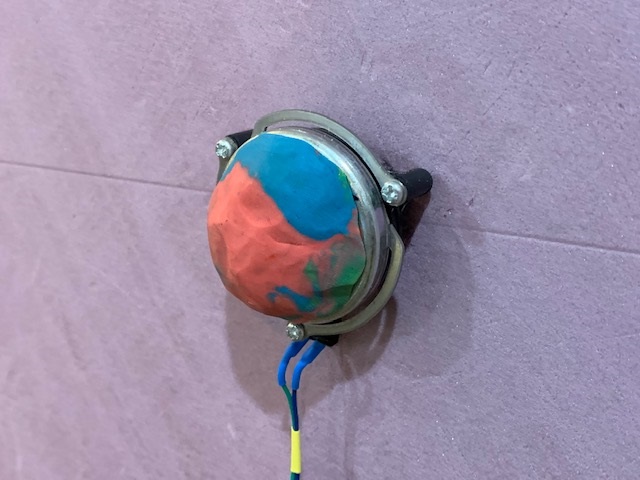
I almost forgot to mention, I am powering them with my very best reference amp and that seems to make a very nice difference. Source are FLAC or WAV files from Jriver on PC through Focusrite 2i4 DAC feeding a Yarra/Melbourne preamp, which drives a 50w SE Class A amp with microwave transformer 67mH 0.5DCR choke reactive load and SLB power supply with 37Vdc and 4.7A bias current (Hugh Dean's Glass Harmony). So, give it your best amp, you might be surprised how good it sounds!
Attachments
Last edited:
Thanks XRK for those sources. I'm looking for good test material. Can someone also provide some digital sources (stream/FLAC/CD) that can show the amazing difference between a Cone Speaker and a DML either in the spacious soundstage area or especially in the barely imperceptible things that you can clearly hear in a DML but pretty much can't in a cone speaker, because of resolution or other issues. I.e., What I effectionately call the "WTF recordings". Those recordings you have heard a million times over on some great cone speakers of any design and then you tried them on your inexpensive experimental DML panel and there magically appeared sounds you have never heard before.
- Home
- Loudspeakers
- Full Range
- A Study of DMLs as a Full Range Speaker
